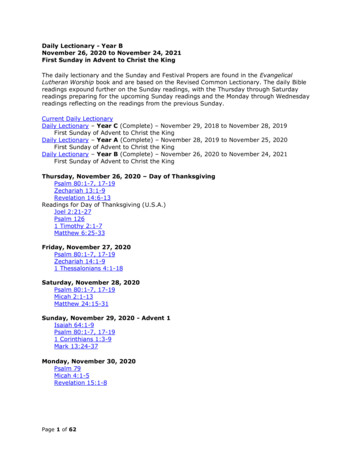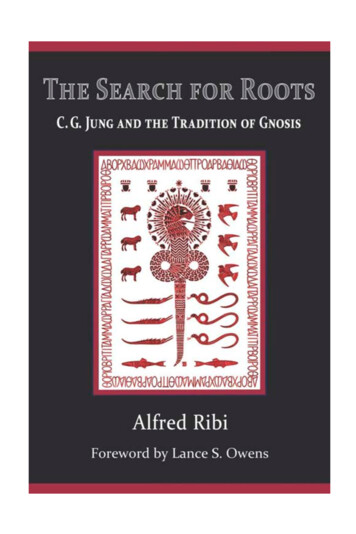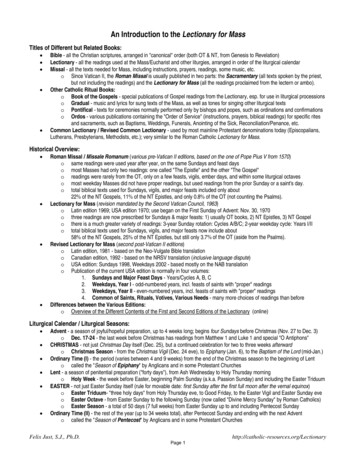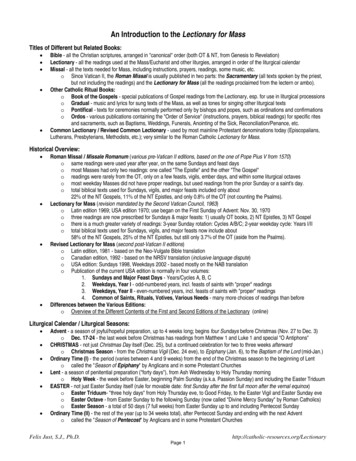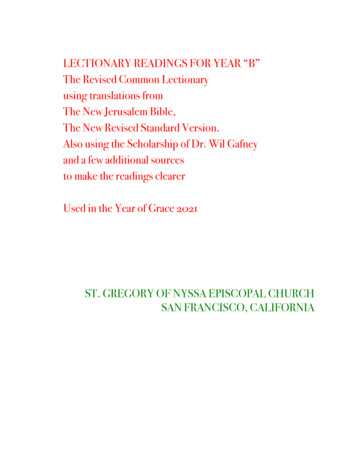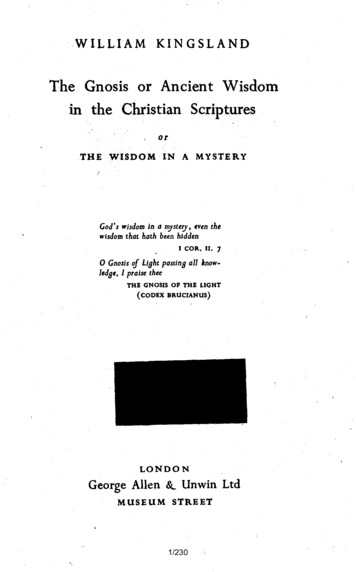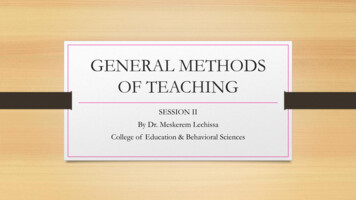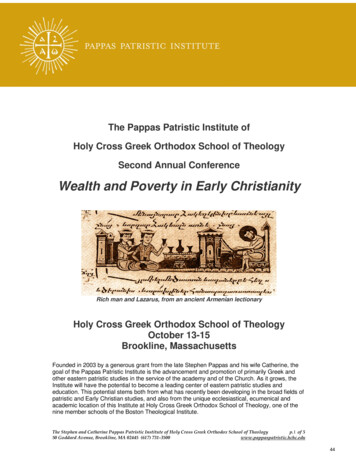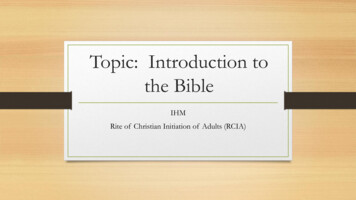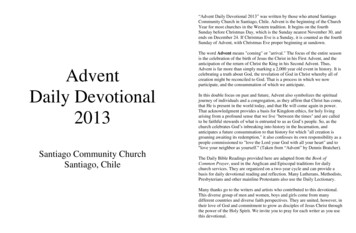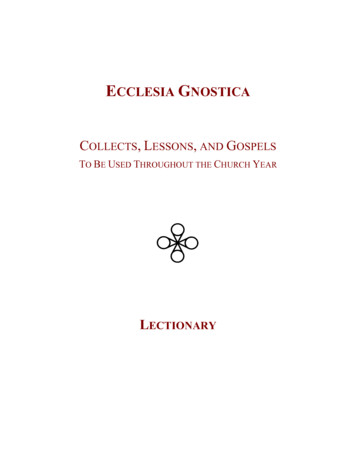
Transcription
ECCLESIA GNOSTICACOLLECTS, LESSONS, AND GOSPELSTO BE USED THROUGHOUT THE CHURCH YEARLECTIONARY
1975, 2010 Ecclesia Gnostica Most Rev. Stephan A. HoellerFurther information available at:www.gnosis.org
An Introduction to the Gnostic LectionaryIt is a time honored practice of sacramental Christendom to makeavailable to its communicants selected passages of sacred scripture,marshaled in accordance with the holidays and seasons of the ChurchYear. The Roman Missal as well as the Roman Breviary (especially intheir pre-Vatican II form) are eminent and admirable examples ofsuch selections. While the Protestant emphasis on a non-selectivereading of scripture has robbed some of Christendom of the use ofLectionaries (as such selections are often called) such books retaintheir value to this day. The Gnostic Church possesses a uniquelectionary in the English language which is enjoying an increasingpopularity. It is known officially mainly by its descriptive title: TheCollects, Lessons and Gospels to be used throughout the Church Yearand was issued under the authority of the bishop of the EcclesiaGnostica in America in 1974.The Gnostic Church is a Christian church and considers itself as apart of the One, Holy, Catholic and Apostolic Ecclesia founded by theLogos and His apostles. In view of this, it is evident that the canonicalChristian scriptures would be well represented in its Lectionary. Theavailability of a fairly large number of Gnostic scriptures in our daysmakes it possible as well as desirable, however, that scriptures of thespecifically Gnostic corpus should be included in fair numbers. Inaddition to the canonical Christian and the Gnostic scriptures, itseemed also desirable to include a certain number of gnosticallyrelated writings, such as the Hermetic, the Mandaean and the Catharscriptures as well as the Chaldean Oracles. The Lectionary is not of auniversalistic character and thus it does not include writings fromtraditions other than the Christian Gnostic, although the closestrelatives of this tradition, i.e. the Manichaean, Mandaean andHermetic documents are represented also. Contemporary scholarshiprecognizes that Hermeticism with its texts, such as the CorpusHermeticum, the Poimandres, and others, is but a non-Christianvariant of Gnosticism, as is the Mandaean religion. Manichaeanism isiii
in fact more Christian than the former two schools of thought. TheProphet Mani considered himself a spiritual apostle of Jesus Christ,and the Manichaeans used several known Christian scriptures, such asthe Gospel According to Thomas. There exists sufficient justificationtherefore, for the inclusion of all of these variants of the Gnostictradition.The various Sundays and Holidays of the Church Year haveascribed to them special intentions. The collects, lessons (sometimesknown as epistles in other lectionaries and liturgies) and gospels havebeen carefully selected so as to express, as far as possible, theintentions of the Sundays and Holidays. Of the collects, twenty-fourare taken from Manichaean sources. (A collect is a prayer manifestinga central keynote or point). The brake-down of the sources of thelessons is as follows: Manichaean, 14; Pistis Sophia, 3; other pre-NagHammadi scriptures, 14; Hermetic Writings, 4; Mandaean Scriptures,3; Cathar Scriptures, 1; Chaldean Oracles, 3; other miscellaneousGnostic sources, 4; Canonical Scriptures (both Old and NewTestament), 39. The gospels in the Lectionary are taken from thefollowing scriptures: Manichaean, 1; Pistis Sophia, 3; other Pre-NagHammadi scriptures: 4; Gospel According to Thomas: 18; Gospel ofTruth, 7; Gospel of Philip, 19; Hermetic Writings, 2; CatharScriptures, 2; Canonical Scriptures (both Old and New Testament),31. The Lectionary comprises one hundred and eighty-eight pages,including seven pages of occasional collects to be used at thediscretion of clergy either within or outside of the context of theEucharist.Scriptures for Private StudyGnostic clergy and communicants ought to be particularly awareof what may be called the primary sources of Gnostic teachings. Aprimary source is a scripture that comes to us directly from the ancientGnostics themselves. Among these primary sources we find, first theNag Hammadi Library, and second, the codices and treatises whosediscovery precedes the Nag Hammadi find. The latter are: the Askew,Bruce and Berlin Codices, the Acts of Thomas, Acts of John, and afew others. Less reliable because of their anti-Gnostic bias, and noiv
longer qualifying as primary sources, are the references andquotations of Gnostic content in the writings of certain ChurchFathers, Epiphanius, Irenaeus and others, who, for the most part, actedas polemicists against the Gnostic teachers of the early Christiancenturies. Although certainly biased and often distorted, theinformation in these sources is still often quite informative.To address ourselves first to the most important primary source,we must turn now to the Nag Hammadi Library of Gnostic writings.There are six separate major categories of writings, when they areanalyzed according to subject matter. They are as follows:1. Alternative versions of creation and salvation. These are: TheApocryphon of John (two versions); The Hypostasis of theArchons; On the Origin of the World; The Apocalypse of Adam;The Paraphrase of Shem.2. Observations and Writings of creative and redemptivemythology, including Gnostic commentaries on diverse Gnosticthemes, such as the nature of reality, the nature of the soul, therelationship of the soul to the world: The Gospel of Truth; TheTreatise on the Resurrection; The Tripartite Tractate; The Tractateof Eugnostos the Blessed (two versions); The Second Treatise ofthe Great Seth; The Teachings of Sylvanus; The Testimony ofTruth.3. Liturgical and initiatory texts. (These may be of special interestto persons of sacramental and initiatic interests): The Treatise onthe Eighth and Ninth; The Prayer of Thanksgiving; TheValentinian Exposition; The Three Steles of Seth; The Prayer ofthe Apostle Paul. (The Gospel of Phillip, listed under category 6,does in part have great relevance to this category also, for it is ineffect a treatise on Gnostic sacramental theology).4. Writings dealing primarily with the feminine deific andspiritual principle, particularly with the Divine Sophia: TheThunder: Perfect Mind; The Thought of Norea; The Sophia ofJesus Christ; The Exegesis of the Soul.5. Writings pertaining to the lives and experiences of some of theapostles: The Apocalypse of Peter; The Letter of Peter to Phillip;v
The Acts of Peter and the Twelve Apostles; The First and SecondApocalypses of James; The Apocalypse of Paul.6. Last but certainly not least, the scriptures which containsayings of Jesus as well as descriptions of incidents in His life:The Dialogue of the Saviour; The Book of Thomas the Contender;The Apocalypse of James; The Gospel of Phillip; The GospelAccording to Thomas.This leaves a small number of scriptures of the Nag HammadiLibrary which may be called "unclassifiable." It also must be kept inmind that the passage of time and translation into languages verydifferent from the original have rendered many of these scripturesabstruse in style. Some of them are difficult reading, especially tothose not familiar with Gnostic imagery, nomenclature and the like.Lacunae are also present in some of these scriptures. The most readilycomprehensible of the Nag Hammadi scriptures is undoubtedly TheGospel According to Thomas, with The Gospel of Phillip and theGospel of Truth as close seconds in order of easy comprehension.There are various translations of most of these scriptures available;the most complete being the one volume collection The NagHammadi Library in English, (edited by J. Robinson) which is readilyavailable.The Gnostic writings, whose discovery precedes that of the NagHammadi Library have been in large part accurately andsympathetically translated by the late scholarly Theosophist, G.R.S.Mead, in such works as Pistis Sophia, Fragments of a Faith Forgotten,and his series of smaller books, entitled Echoes from the Gnosis.Mead's works have been reprinted in recent, albeit probably small,editions. There is also an excellent selection of Gnostic writings of thepre Nag Hammadi variety, entitled The Gospel of the Gnostics, editedby another outstanding scholar and Theosophist, Duncan Greenlees.The same scholar has also edited and published a very fine selectionof Manichaean writings under the title, The Gospel of the ProphetMani. Both of these fine books are out of print, but may be obtainedin Libraries of the Theosophical Society for study.vi
Over two decades have elapsed since the complete translations ofthe Nag Hammadi Library was completed and published. Theexegetical literature based on these writings is slowly growing.Curiously enough, one of the most useful books of this sort is still onewhich was published very soon after the Nag Hammadi Library: TheGnostic Gospels by Elaine Pagels. Some other useful authors in thisfield are: Bentley Layton, Giovanni Filoramo, Simone Petrement, DanMerkur, Marvin Meyer and Ioan Couliano. An increasing number ofbooks employing the name "Gnostic" in their titles are being sold. Theusefulness and authenticity of such literature need to be evaluated andjudged by individual students on a case by case basis. (Visit theGnosis Archive reading list for an annotated list of books suitable forfurther study,)ConclusionIt is important to remember that later varieties and recensions ofGnostic teachings are present in virtually all transmissions of theoccult tradition in the West. Some of these later variations resemblethe original model more closely than others. Clergy, members andother persons interested in the Gnostic Church sometimes also possessMartinist, Masonic, Rosicrucian, Theosophical and similar affiliationsand dedications. All of these schools of thought, whether theyacknowledge it or not, are related not only to each other, but by wayof historical and mystical descent also to the matrix of ancientGnosticism. (Certainly some of the leading figures of thesemovements have acknowledged their relationship to Gnosticism, asH.P. Blavatsky's numerous writings on the Gnostics exemplify).Whatever the other interests and dedications of all of us may be,we are Gnostics. We are Gnostics moreover, not only in the sense ofpursuing, or possessing a quality of consciousness that might be calledGnosis, but we are members of a specific tradition. This tradition, theGnostic tradition, is the one represented by the Gnostic Church. Itmay be true that the non Gnostic branches of Christendom have orclaim a certain kind of Gnosis, which they may call at times"Apostolic" or by any other name. Aspects of the Gnosis have passedinto many hands over the centuries. Yet, we must not be satisfied withvii
that which is in part, for we are heirs of the fullness, the Pleromaitself. And this is the principal reason for our interest in anddedication to the Gnostic Scriptures. These scriptures are one of ourchief links with our origins. (The other links are the seven mysteries,or Sacraments and the arcane, oral tradition). It is by way of thesescriptures that we may in large measure join ourselves consciouslywith the Fathers of the Gnosis, great sages like Valentinus, Basilidesand their company. It is also thus, that through them, we are joined tothe Holy Apostles and through them to their and our Master, JesusChrist, the most precious flower of the Pleroma, the Logos, thePansother, the fountainhead of all true Gnosis.Stephan A. Hoeller, Ep.Gn.Tau Stephanus Iviii
THE LECTIONARYCOLLECTS, LESSONS AND GOSPELSIn the following readings, “color” indicatesthe appropriate liturgical color for the day.The meditational intention of each day is also noted.
ADVENT SUNDAYColor: VioletIntent: Seeking the LightTHE COLLECTO Thou, the Heart of Silence, the Hidden Mystery, the inner God: the gods adoreThee, we adore Thee, seated within the Shrine of our hearts. We greet Thee, Thoucreator of beings, Thou the One Self. We adore the holy Souls that come forth fromThee, that share Thy being, that are Thyself. O Thou that art hidden, yet everywheremanifest, we worship Thee in greeting each God-soul that cometh forth from Theeand liveth in us. Amen.THE LESSONThe lesson is taken from the Book of Sophia:Seek, all of you, after the Light, so that the power of your Soul that is in you maylive. Do not desist from seeking by day and by night, until you find the purifyingmysteries of the Light which refine the body of matter and make it a pure Light veryrefined. Do to all men who come to you and believe in you and listen to your wordswhat is worthy of the mysteries of the Light, give the mysteries of the Light and donot hide them from them. For he who shall give life to a single soul and liberate it,besides the Light that is in his own soul, he shall receive other glory in return for thesoul he has liberated.Here endeth the lesson.-1-
THE GOSPELThe gospel is taken from the Gospel according to St. Thomas:Jesus said: Whoever finds the meaning of these words will not taste death. Lethim who seeks, not cease seeking until he finds, and when he finds, he will betroubled, and when he has been troubled, he will marvel, and he will reign over theAll. Jesus said: If those who lead you, say to you, “See, the Kingdom is in heaven”,then the birds of heaven will precede you. If they say to you, “See, it is in the sea”,then the fish will precede you. But the Kingdom is within you and it is without you.If you know yourselves, then you will be known and you will know that you are thesons of the Living Father. But if you do not know yourselves, then you are inpoverty and you are poverty.Here endeth the Gospel.-2-
THE SECOND SUNDAY IN ADVENTColor: VioletIntent: The God WithinTHE COLLECTShow us Thy face, O holy undefiled radiance, our true gracious physician, Thouhealer of our souls! Come to us, for we are Thy sheep, and Thou art our goodshepherd! O Light of our soul, the sun of our heart who givest our being the thingsof the Light, Thou art our witness that we have no comfort save in Thee. We haveheard every voice but no other voice save Thine can please us; for it is Thou alonewhom we have loved from the beginning to the end. Come to us, and abide with us,O redeeming Light, Thou who art the cross of light that gives life to the universe.Amen.THE LESSONThe lesson is taken from the writings of the Gnostic Fathers:Cease to seek God in created things on the outside, but seek Him within thyself;and thus learn who it is that takes possession of thee and says: “My God, myconsciousness, my understanding, my soul, my body.” Then learn whence issorrow, and rejoicing, and love, and hate, and being awake, and being asleep, andgetting angry against one’s will. Now if thou inquire into these things thou shaltfind Him in thyself, one and many, like the atom, and thus thou shalt find the wayout from thy lesser self.Here endeth the lesson.-3-
THE GOSPELThe gospel is taken from the Gospel according to St. Philip:Those who sow in the winter reap in summer. The winter is the world, thesummer the other aeon. What comes out of the winter is the summer. Let us sow inthe world that we may reap in summer. But if any man reap in winter, he will notreap but pluck out.Here endeth the gospel.-4-
THE THIRD SUNDAY IN ADVENTColor: Violet or RoseIntent: Recognition of the MessengerTHE COLLECTO Christ, our Light, come to us and take us unto Thee! We have trusted to theknowledge of Thy hope which called us unto Thee; take us up to Thine abode, Oour celestial Spouse! We are trees in the orchard of Thy Light; our Light shines likethe sun; for we have lit it with Thy fire, and nourished it with the good oil of purity.O Thou who art our eternal saving power, cleanse us in Thy waters, that we maybecome divine again as we once were. And come to us, O Thou dearly awaited One,come to those who await Thee today and forever. Amen.THE LESSONThe lesson is taken from the words of the Holy Prophet Mani:The Messenger of Light, who comes at the right time and assumes the form of thetrue church and human flesh, and acts as leader within righteousness, chooses thepersonalities of his disciples and then frees them, both those of the Elect and thoseof the Hearers; he dives down into the deep oceans of the waters of the world, anddraws them out from the jaws of the deep. And they do not stray again, but afterother rebirths and toil for the Light, they come to the hands of the Angels; and theAngels carry them to the places where they shall be refined as pure gold.Here endeth the lesson.-5-
THE GOSPELThe gospel is taken from the secret sayings of Jesus:Jesus said: Pay no heed to the multitude; and think little on those outside of themystery; for know that I am wholly with the Father, and the Father with me.Therefore I have suffered nothing of what they are going to say about me. For whatthou seest, this I have shown thee; but what I am, this alone I know, no other. Letme then keep what is mine, and see what is thine through me. But see me truly, notwhat I said I am, but what thou being akin to me, canst fully realize, and wilt knowin the fullness of thy time.Here endeth the gospel.-6-
THE FOURTH SUNDAY IN ADVENTColor: VioletIntent: Nature of the RedeemerTHE COLLECTO, Thou our Redeeming Power, our mind has not ceased thinking of Thywonders; our thought has not swerved from searching Thy secrets. Our insight hasnot moved from aspiring to Thy mysteries; nor has our counsel ever moved fromseeking Thy marvels. Our wills have sent up desiring to comprehend Thee, our lord.We long to see Thy brilliant countenance, O ever coming Lord! Amen.THE LESSONThe lesson is taken from the words of the Holy prophet Mani:When men asked for the Redeemer, and the Mother of Life, and the first Man andthe Spirit of Life decided to send to their children One who should free them andsave them, to show them the knowledge and the righteousness and rescue themfrom evil. Being kindly, and filled with pity, the Good Father sent from His bosomHis beloved Son into the heart of the earth and into its lowest parts for the saving ofsouls. While coming, the Son changed himself into the form of man, and Heappeared to men as a man, being no man, and men fancied him to have been born.Here endeth the lesson.-7-
THE GOSPELThe gospel is taken from the Book of the Gnosis of the Light:The ever coming Redeemer gave us glory and joy, and jubilation, happiness andpeace and hope, and faith and love and truth which changes not. And we havebecome blessed and perfect, we have come to know God as truth, and we havebecome gods and perfected ones. And he also gave us the law: to love one another,and to honor God and bless Him, and seek Him — who He is and what He is — thatwe should wonder at the place whence we have come, and not return to evil againbut follow after Him who has given us the Law of Love.Here endeth the gospel.-8-
THE NATIVITY OF THE DIVINE LIGHT: CHRISTMAS DAYColor: White Intent: Incarnation of the RedeemerTHE COLLECTO Father, true God, Who leadest us out of the darkness, we bless Thee, theadored of souls granting us blessed vision and instruction. Thou, our Father, art theroot of all wisdom; through Thy will, the beloved Logos has spread out over us themighty gift of the knowledge of holy things; he has taught us what used to be, whatare, and what shall be; he has rescued us from darkness. We thank Thee Father, forall the great messengers of the Light Thou hast sent to us, in whom Thy holy Wordhad been made flesh. All the mysteries are fulfilled in Thee, our Father, and Thoufulfillest them in us. Amen.THE LESSONThe lesson is taken from the words of the Holy Prophet Mani:Jesus, Thy burden is light for him who can carry it. Many are the marvels of Thynativity, O Jesus; yet when we say “Thy nativity,” who could have created Thee, OLord Jesus, Thou who art eternally life from life? The Son of God cast into ahumble womb; he who is the all, in whom the all exists. He came down to the flesh,he put on the vesture of humanity. God became man; he went about in the land, hetook a man’s likeness, the raiment of a slave. He came for all the sheep of his flock,because he knew there was no other to rescue them. He had come without a body,yet his apostles declared of him that he took the form of a boy, an appearance likethat of us, men; he came down and manifested in the world among the people of theJews.Here endeth the lesson.-9-
THE GOSPELThe gospel is taken from the second chapter of the Gospel according to St.Luke:And it came to pass in those days, that there went out a decree from CaesarAugustus, that all the world should be taxed. And all went to be taxed, every oneinto his own city. And Joseph also went up from Galilee, out of the city ofNazareth, into Judaea, unto the city of David, which is called Bethlehem; becausehe was of the house and lineage of David: to be taxed with Mary his espoused wife,being great with child.And so it was, that, while they were there, the days were accomplished that sheshould be delivered. And she brought forth her first born son, and wrapped him inswaddling clothes, and laid him in a manger; because there was no room for them inthe inn. And there were in the same country shepherds abiding in the field, keepingwatch over their flock by night. And, lo, the angel of the Lord came upon them, andthe glory of the Lord shone round about them: and they were sore afraid. And theangel said unto them, “Fear not: for, behold, I bring you good tidings of great joy,which shall be to all people. For unto you is born this day in the city of David aSavior, which is Christ the lord. And this shall be a sign unto you; ye shall find thebabe wrapped in swaddling clothes, lying in a manger.” And suddenly there waswith the angel a multitude of the heavenly host praising God, and saying “Glory toGod in the highest and on earth peace to men of goodwill.”Here endeth the gospel.- 10 -
NEW YEAR’S DAYColor: WhiteIntent: Renewal of LifeTHE COLLECTO omnipotent God, who fillest and dost govern the immensity of worlds whichhave come forth from Thee; Thou verily art the eternal new-born Child, and yetThou art the Ancient of Days! Thou hast veiled Thy ineffable glory and splendor inthe garment of time and the cloak of space; Thou wilt transform all things so thatthey might return to Thee, to Thy timeless essence. We dedicate our lives to Thee,and we resolve to so live throughout this year, that Thy glory might increase and fillthe earth as the waters cover the sea. Amen.THE LESSONThe lesson is taken from the Book of the Revelation of St. John the Divine:Behold, the tabernacle of God is with men, and He will dwell with them, and theyshall be His people, and God himself shall be with them, and be their God. AndGod shall wipe away all tears from their eyes; and their shall be no more death,neither sorrow, nor crying, neither shall there be any more pain; for the formerthings are passed away. Behold, I make all things new.Here endeth the lesson.- 11 -
THE GOSPELThe gospel is taken from the words of Hermes the Thrice Great Lord:Your consciousness is in God; draw it into yourself, and it will appear; will, andit takes birth; suspend the senses of the body and the birth of the Godhead takesplace. But first you must purify yourselves from the mindless torments of matter,one of which is ignorance, though there are many others, which force the man whois confined to the prison of the body to suffer by way of the passions. But these atonce depart from him on whom God has had mercy, and so the body of Gnosis inman is built. This is the way of true rebirth. And now my child be still, and keepsolemn silence; and thus will the grace from God not cease to come upon us.Here endeth the gospel.- 12 -
THE EPIPHANYColor: WhiteIntent: Divine GuidanceTHE COLLECTHoly Father of the Light, who dost ever show Thyself to the wise men in everyage, we ask for such zeal in the pursuit of Gnosis as may help us to lead all longingsouls to Thy Light; O Thou ever shining and guiding star of wisdom and holiness,to Whom we present our gifts of devotion and adoration now and forevermore.Amen.THE LESSONThe lesson is taken from the writings of the Gnostic Fathers:When the Christ appeared among the Aeons of Light, and the chaos wasdispersed and perfectly pacified, all the sons and daughters of wisdom sang hymnswith great joy to the Father, sharing much delight. With one will and purpose theentire Fullness of the Aeons — Christ and the Spirit were well pleased and theFather imposed His seal upon all. And this is the most perfect beauty and Star of thePleroma, a perfect fruit, Jesus who was also named Savior and Christ and Word andAll, because he is from all.Here endeth the lesson.- 13 -
THE GOSPELThe gospel is taken from the Book of the Gospel of Truth:Therefore he who is Gnostic is truly a being from above. When he is called hehears; he answers; he directs himself to Him who calls him and returns to Him; heapprehends how he is called. By possessing Gnosis, he carries out the will of Himwho called him and seeks to do what pleases Him. He receives the repose. He whothus possesses knowledge knows whence he comes and whither he goes. Heunderstands as someone who makes himself free and awakens from thedrunkenness wherein he lived and returns to himself.Here endeth the gospel.- 14 -
THE SECOND SUNDAY AFTER EPIPHANYColor: GreenIntent: Desire for LiberationTHE COLLECTO great ‘Call’ who has awakened our soul from slumber; O Merciful One filledwith mercy, the savior of those who are his own. We worship thee; we have calledupon thee with an innocent voice, because we know that thou art the rescuer ofsouls. Stretch out thy right hand to us, and we shall leave all darkness behind us,and serve only thy Light, now and forevermore. Amen.THE LESSONThe lesson is taken from the Book of the Psalms of Light:O Soul, thou art the sheep that has wandered in the desert; thy Father seeks thee,thy shepherd looks for thee. O despised noble, thy king searches after thee! Whereare thy angel garments, thine unaging robes? Where are thy gay garlands, thycrowns that do not fall? Who has changed thy fair beauty, the fashion of thykinsmen, the seal of thy fathers? Move thyself, O soul watching in the enduringchains, and remember the ascent into the joyful air, for a dangerous lure is thesweetness of this flesh, the body of darkness. Drink of the water of memory, throwaway thy forgetfulness! The wounded one who desires healing, let him come to thephysician! O soul, do not forget thy Self, nor faint, nor eat out thy heart! See, theships are moored for thee, the boats are in the harbor; take thy burden aboard andsail away to thy true home.Here endeth the lesson.- 15 -
THE GOSPELThe gospel is taken from the Gospel according to St. Thomas:Jesus said: The old man will not hesitate to ask a little child of seven days aboutthe place of Life, and he will live. For many who are first shall become last, andthey shall become a single one. Jesus said: Know what is in thy sight, and what ishidden from thee will be revealed to thee. For there is nothing hidden which will notbe manifest. His disciples asked him, they said to him: Wouldst thou that we fastand how should we pray and should we give alms and what diet should we observe?Jesus said: Do not lie; and do not do what you hate, for all things are manifestbefore Heaven. For there is nothing hidden that shall not be revealed and there isnothing covered that shall remain without being uncovered.Here endeth the gospel.- 16 -
THE THIRD SUNDAY AFTER EPIPHANYColor: GreenIntent: SincerityTHE COLLECTO Indwelling Lord, who art ever opposed to injustice and hypocrisy, we pray thatwe may be just and true of heart in all our dealings with our brethren, that we mayrecognize within them Thy indwelling presence and holy light. O Thou great Kingof Righteousness, to whom be praise and adoration for ever and ever. Amen.THE LESSONThe lesson is taken from the Book of Sophia:Preach to the whole world: fight yourselves and receive the mysteries of theLight in this afflicted time, and go into the kingdom of the Light. Do not add day today or cycle to cycle, hoping to come to receive the mysteries when we come to theworld in another cycle. Now such people do not know when the number of thePerfect Souls will be complete, and I shall shut the Gates of Light, and from thattime no one shall go in, because the mystery of the first mystery has beenaccomplished, for whose sake the universe has come into being.Here endeth the lesson.- 17 -
THE GOSPELThe gospel is taken from the Gospel according to St. Philip:When the pearl is cast down into the mud it does not become dishonored themore, nor if its anointed with balsam oil will it become more precious. But it has itsworth in the eyes of its owner at all times. So with the Sons of God wherever theymay be. For they have the value in the eyes of their Father.Here endeth the gospel.- 18 -
THE FOURTH SUNDAY AFTER EPIPHANYColor: GreenIntent: The Overcoming of SorrowTHE COLLECTO our Father, our God, our Savior, our Ruler, allow us to be Thy champions,allow us to do battle for Thee! O Maiden, our Beloved, the Living fire, we shallgive ourselves to Thee, we shall give our body to death for the sake of Thy body,and give our beauty for the sake of Thy fair beauty! Allow us to untie the knot ofworldly attachments, to break the bond of action; allow us to lead the one goneastray, heal the long incurable disease of the passions of this world, and open oureyes to Wisdom! Give us grace so that on every side we may become bestowers ofjoy on those who have come to sorrow! Amen.THE LESSONThe lesson is taken from the writings of the Holy Prophet Mani:It is good for us to be silent; let us not think in our heart that our God is forgetfulof us, for befor
Gospel According to Thomas, with The Gospel of Phillip and the Gospel of Truth as close seconds in order of easy comprehension. There are various translations of most of these scriptures available; the most complete being the one volume collection The Nag Hammadi Library
